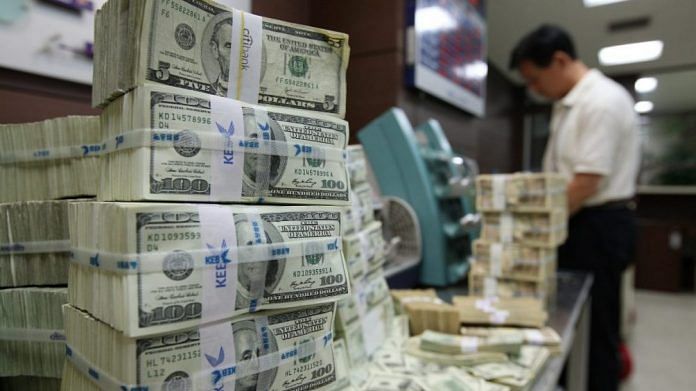Drop being attributed to RBI’s efforts to arrest rupee fall but experts say no reason to panic for now.
New Delhi: India’s foreign exchange reserves dropped below the $400 billion mark to $399.28 billion as on 7 September, breaking a symbolic barrier that had been scaled for the first time exactly a year back.
The drop in forex reserves was primarily due to the RBI’s aggressive efforts to arrest the rupee’s steady fall.
India’s forex reserves touched a record $426 billion in April but has been falling since. “A solution is being worked out and that will soon be announced…several informal meetings on this issue have been held,” a finance ministry official, who spoke on condition of anonymity, told The Print.
Also read: No stopping fall in India’s forex levels, it now touches $400.8 billion
The central bank has already spent about $14 billion in the first quarter of the current financial year in a bid to reduce volatility in the exchange rate.
Axis Bank’s chief economist Saugata Bhattacharya, however, said that the dip in forex reserves could also be due to a change in valuation. “This is not alarming and a lot depends on the component of the reserves. When the dollar strengthens compared to other currencies, there could be fluctuations,” Bhattacharya said.
Sources said that the government and the central bank are set to finally resort to raising funds through NRI bonds to support the rupee, which has lost about 13 per cent in 2018.
The falling rupee
Earlier in the week, the rupee hit an all-time low of 72.91 to a dollar.
While all currencies across the world have depreciated, the rupee has been the worst performing Asian currency this year. China’s exchange rate has depreciated by 5.2 per cent this year while Malaysia’s by 2.7 per cent and in Thailand it is a mere 0.6 per cent.
Uncertainty in the global markets has increased the fears of an imminent trade war between various countries including the US and China.
“This situation is worrisome because it is not limited to India. We have become vulnerable due to a widening current account deficit (CAD), the result of the oil import bill and trade deficit,” said Abhijit Sen, former member, Planning Commission. “Having said that, we have enough reserves at this point and there is no need to worry but the government too should give out that message”.
A recent State Bank of India report said that the rupee depreciation was likely to continue as the central bank had limited intervention power and this could put pressure on the current account deficit– the difference between inflow and outflow of foreign currency. According to the report, CAD has touched 3 per cent as against the 2.8 per cent estimated earlier.
Need to have a healthy forex reserve
Healthy forex reserves help in the country’s international payments while providing the necessary support in case of a sudden outflow of dollars. Currency experts said there was no reason for panic and the current level — though below the $400 billion mark — was comfortable.
Also read: RBI steps in after India’s forex reserves soon to dip below $400 billion
Strong inflows from foreign portfolio investors and foreign direct investments till April pushed the country’s forex reserves, which peaked on 13 April.
The political conundrum
The falling rupee and the drop in the forex reserves have caused worry for the BJP-led NDA, especially with elections inching closer.
After the rupee breached the psychological 70 to a dollar level, Congress President Rahul Gandhi took to Twitter to slam the government.






